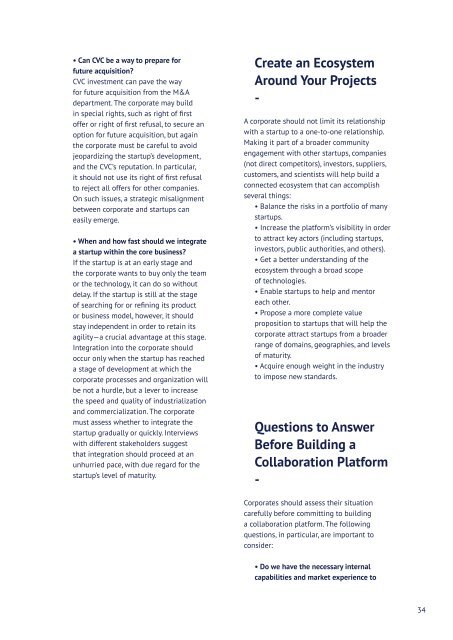From Tech to Deep Tech
from-tech-to-deep-tech
from-tech-to-deep-tech
You also want an ePaper? Increase the reach of your titles
YUMPU automatically turns print PDFs into web optimized ePapers that Google loves.
• Can CVC be a way <strong>to</strong> prepare for<br />
future acquisition?<br />
CVC investment can pave the way<br />
for future acquisition from the M&A<br />
department. The corporate may build<br />
in special rights, such as right of first<br />
offer or right of first refusal, <strong>to</strong> secure an<br />
option for future acquisition, but again<br />
the corporate must be careful <strong>to</strong> avoid<br />
jeopardizing the startup’s development,<br />
and the CVC’s reputation. In particular,<br />
it should not use its right of first refusal<br />
<strong>to</strong> reject all offers for other companies.<br />
On such issues, a strategic misalignment<br />
between corporate and startups can<br />
easily emerge.<br />
• When and how fast should we integrate<br />
a startup within the core business?<br />
If the startup is at an early stage and<br />
the corporate wants <strong>to</strong> buy only the team<br />
or the technology, it can do so without<br />
delay. If the startup is still at the stage<br />
of searching for or refining its product<br />
or business model, however, it should<br />
stay independent in order <strong>to</strong> retain its<br />
agility—a crucial advantage at this stage.<br />
Integration in<strong>to</strong> the corporate should<br />
occur only when the startup has reached<br />
a stage of development at which the<br />
corporate processes and organization will<br />
be not a hurdle, but a lever <strong>to</strong> increase<br />
the speed and quality of industrialization<br />
and commercialization. The corporate<br />
must assess whether <strong>to</strong> integrate the<br />
startup gradually or quickly. Interviews<br />
with different stakeholders suggest<br />
that integration should proceed at an<br />
unhurried pace, with due regard for the<br />
startup’s level of maturity.<br />
Create an Ecosystem<br />
Around Your Projects<br />
-<br />
A corporate should not limit its relationship<br />
with a startup <strong>to</strong> a one-<strong>to</strong>-one relationship.<br />
Making it part of a broader community<br />
engagement with other startups, companies<br />
(not direct competi<strong>to</strong>rs), inves<strong>to</strong>rs, suppliers,<br />
cus<strong>to</strong>mers, and scientists will help build a<br />
connected ecosystem that can accomplish<br />
several things:<br />
• Balance the risks in a portfolio of many<br />
startups.<br />
• Increase the platform’s visibility in order<br />
<strong>to</strong> attract key ac<strong>to</strong>rs (including startups,<br />
inves<strong>to</strong>rs, public authorities, and others).<br />
• Get a better understanding of the<br />
ecosystem through a broad scope<br />
of technologies.<br />
• Enable startups <strong>to</strong> help and men<strong>to</strong>r<br />
each other.<br />
• Propose a more complete value<br />
proposition <strong>to</strong> startups that will help the<br />
corporate attract startups from a broader<br />
range of domains, geographies, and levels<br />
of maturity.<br />
• Acquire enough weight in the industry<br />
<strong>to</strong> impose new standards.<br />
Questions <strong>to</strong> Answer<br />
Before Building a<br />
Collaboration Platform<br />
-<br />
Corporates should assess their situation<br />
carefully before committing <strong>to</strong> building<br />
a collaboration platform. The following<br />
questions, in particular, are important <strong>to</strong><br />
consider:<br />
• Do we have the necessary internal<br />
capabilities and market experience <strong>to</strong><br />
34




